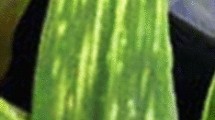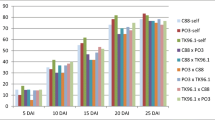Summary
A Lolium multiflorum/Festuca arundinacea hybrid (amphiploid) and three successive generations from backcrosses to L. multiflorum, together with the two parental populations, were screened for resistance to some diseases that commonly attack either or both of the parent species. Where, as with Rhyncho-sporium secalis, both species were susceptible to infection, the amphiploid was also susceptible. Where one or other of the parents was highly resistant, the amphiploid was equally resistant; this occurred with Puccinia coronata var. lolii, P. coronata var. festucae, Drechslera dictyoides and ryegrass mosaic virus.
Resistance to P. coronata var. lolii persisted largely into the first and second backcross generations, but had disappeared by the third. Similarly, there were equal proportions of plants immune to ryegrass mosaic virus in first and second backcross generations, but none were immune in the third. However, resistance to this virus appeared more complex. Only one third of progeny from the first backcross could not be infected and the remainder showed a broad range of symptoms from only very mild chlorosis to severe chlorosis and necrosis.
Similar content being viewed by others
References
Braverman, S. W. & J. H. Graham, 1960. Helminthosporium and related species on Festuca spp., Lolium spp., and inter-generic crosses. Phytopathology 50: 691–695.
Brown, M. R., 1937. Study of crown rust Puccinia coronata Corda in Great Britain. Ann. appl. Biol. 24: 504–527.
Cruickshank, I. A. M., 1957. Crown rust of rye grass. N. Z. Jl Sci. Technol. 38: 539–543.
Henson, L. & R. C. Buckner, 1957. Resistance to Helminthosporium dictyoides in inbred lines of Festuca arundinacea. Phytopathology 47: 523.
Kreitlow, K. W. & W. M. Meyers, 1947. Resistance to crown rust in Festuca elatior and F. elatior var. arundinacea. Phytopathology 37: 59–63.
Lewis, E. J., 1966. The production and manipulation of new breeding material in Lolium-Festuca. Proc. X int. Grassld Congr., Helsinki, pp. 688–693.
Mulligan, T. E., 1960. The transmission by mites, host-range and properties of ryegrass mosaic virus. Ann. appl. Biol. 48: 575–579.
Riley, R. & V. Chapman, 1958. The production and phenotypes of wheat-rye addition lines. Heredity, Lond. 12: 301–315.
Schmidt, J. W., W. H. Sill & H. Fellows, 1956. Range of reactions to wheat streak-mosaic virus in hybrids derived from Triticum vulgare x Agropyron elongatum. Agron. J. 48: 371–373.
Shaner, G., J. J. Roberts & R. E. Finney, 1972. A culture of Puccinia recondita virulent to the wheat cultivar Transfer. Pl. Dis. Reptr. 50: 827–830.
Wilkins, P. W., 1973. Infection of Lolium multiflorum by Rhynchosporium species. Pl. Path. 22: 107–111.
Wilkins, P. W. & P. L. Catherall, 1974. The effect of some isolates of ryegrass mosaic virus on different genotypes of Lolium multiflorum. Ann. appl. Biol. 76: 209–216.
Author information
Authors and Affiliations
Rights and permissions
About this article
Cite this article
Wilkins, P.W., Carr, A.J.H. & Lewis, E.J. Resistance of Lolium multiflorum/Festuca arundinacea hybrids to some diseases of their parent species. Euphytica 23, 315–320 (1974). https://doi.org/10.1007/BF00035873
Received:
Issue Date:
DOI: https://doi.org/10.1007/BF00035873




